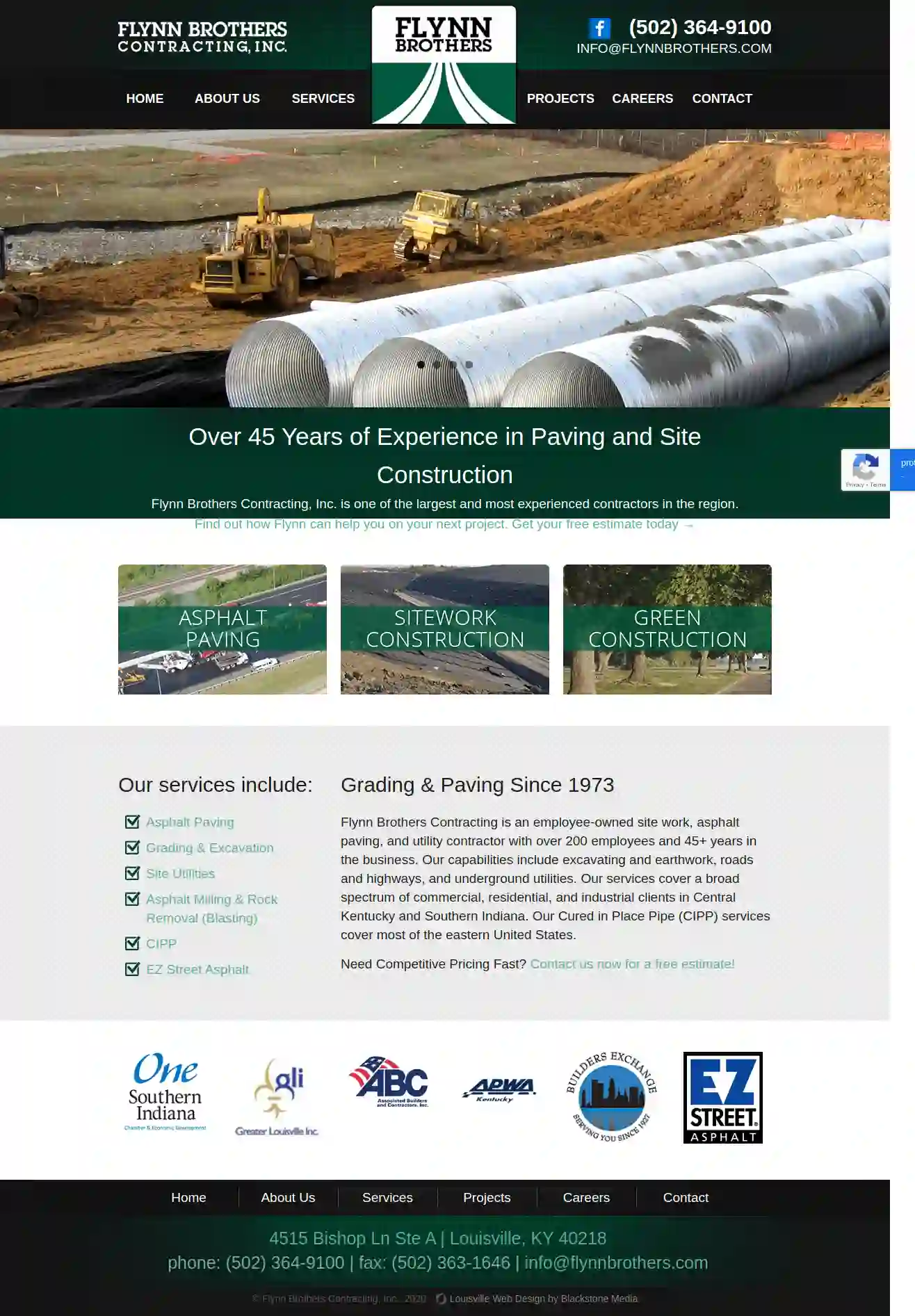Excavation Contractors Walton
Top Land Excavation in Walton
Receive multiple Excavation Contractor quotes for your project today! Compare profiles, reviews, accreditations, portfolio, etc... and choose the best service.

Lawyer Excavation, Inc.
4.424 reviews7841 N Us Highway 31, Seymour, 47274, USWelcome to Lawyer Excavation, Inc. Lawyer Excavation, Inc. was established in 1995 by Glenn & Darrin Lawyer. With combined experience of over 40 years in various fields of excavation, they bring a wealth of knowledge and expertise to every project. Their commitment to communication ensures that all project details are clearly understood by clients, suppliers, and subcontractors, guaranteeing timely completion within budget. Lawyer Excavation, Inc. is dedicated to customer satisfaction, built on a foundation of integrity, professionalism, and dependability. Their focus on repeat business and referrals reflects their commitment to long-term success.
- Services
- Why Us?
- Our Team
- Gallery
Get Quote
ADC Paving and Pavement Maintenance
4.4120 reviews4629 Astor Rd, Louisville, 40218, USTHE TOP PAVING CONTRACTOR OF Kentucky & Indiana Our integrity and our people are our most significant assets. Doing what we say we are going to do by providing people the value they are paying for is our goal with every single job. Asphalt pavement is not an inexpensive product. We make sure that our customers are informed and appropriately educated on their specific needs for their asphalt parking lot or asphalt driveway. Our clients need to know they can count on us. They should be genuinely confident in our ability to perform and have added or sustained a valuable asset to their property. From a customer service perspective, from a project management perspective, from a quality perspective, we walk out of these doors every morning and deliver our best. That is something we live by. Not just the best paving jobs, maintenance jobs, or sealcoating jobs, but also the best from our receptionist, our customer service department, and our crews. That is our vision, goal, and the value we believe every customer deserves. Proudly serving Jeffersontown, Middletown, St. Matthews, River Port, Lyndon, Simpsonville, Shelbyville, Crestwood, La Grange, Jeffersonville, Goshen, New Albany, IN and the surrounding communities. The team translates into our quality. We stress that if we want to be the best, we have to act like the best. Passion a strong liking or devotion Integrity the quality of being honest and having strong moral principles
- Services
- Why Us?
- Testimonials
- Gallery
Get Quote
Stewart Contracting
2.58 reviewsLexington, USWelcome to Stewart Contracting! Stewart Contracting is here to build for you. We offer free quotes and specialize in Barn Building in Lexington, Paris, Versailles and all over Central Kentucky. Our crew is trained to work around your horses and understand safety first when it comes to your horses. References available! RESIDENTIAL or COMMERCIAL Paris, Lexington, Georgetown, Versailles, Nicholasville, Lancaster, Danville and Lexington call Ken 859-621-9011 / FREE QUOTES AVAILABLE Your Central Kentucky General Contractor should be someone who: Has a thorough knowledge and understanding of the coordination and scheduling issues of your construction project Gets things done ON TIME and ON BUDGET Has a team of professionals who works with him to achieve Total Client Satisfaction Has 30 years of experience in Central Kentucky as a General Contractor and hundreds of satisfied customers Takes pride in producing structures that are sound in construction, highly crafted and exquisitely finished Is fully licensed and insured Guarantees their work Works within your Budget Provides Clean, Trustworthy and Dependable Employees Stewart Contracting is proud to be able to say we are this kind of Central Kentucky General Contractor. We are committed to saving you money during the design phase of your project until completion. We are ready to work on all types of buildings, including equine buildings, residential homes and commercial buildings. Our work can include land leveling through the final landscaped finishes. General Contracting for the Equine Industry is our specialty. Our corporate mission is TOTAL client satisfaction by achieving the construction objectives of: quality, on time delivery and staying within the budgets set within every project. This approach ensures that the finished project will compliment the character and the identity of the owner by making a visual statement of design and project criteria.
- Services
- Why Us?
- Gallery
Get Quote
Flynn Brothers Contracting, Inc.
325 reviews4515 Bishop Ln Ste A, Louisville, 40218, USOver 45 Years of Experience in Paving and Site Construction Flynn Brothers Contracting, Inc. is one of the largest and most experienced contractors in the region. Find out how Flynn can help you on your next project. Get your free estimate today → Grading & Paving Since 1973 Flynn Brothers Contracting is an employee-owned site work, asphalt paving, and utility contractor with over 200 employees and 45+ years in the business. Our capabilities include excavating and earthwork, roads and highways, and underground utilities. Our services cover a broad spectrum of commercial, residential, and industrial clients in Central Kentucky and Southern Indiana. Our Cured in Place Pipe (CIPP) services cover most of the eastern United States. Need Competitive Pricing Fast? Contact us now for a free estimate!
- Services
- Why Us?
- Gallery
Get Quote
H. F. McClure Maintenance Service Inc
7701 Dixie Highway, Louisville, 40258, USEst. 1969 H. F. McClure Excavating & Maintenance Service Inc. Our goal then and now is to provide quality work at a competitive price. YOUR LOCAL, PROFESSIONAL EXCAVATORS Where We Build Your Visions H. F. McClure Excavating and Maintenance Service Inc. has been providing excavation in Louisville, KY and the surrounding areas for over 50 years. Our highly trained operators are committed to completing every project with safety and precision. We consider your budget, expectations, site constraints, surrounding buildings, and other factors to determine the best way to meet your needs We Provide the Best Service in Industry H. F. McClure Excavating and Maintenance Svc. Inc. is a family-owned company in Louisville, KY offering top of the line commercial excavation services and underground tank installation.
- Services
- Why Us?
- Gallery
Get Quote
Right Track Excavating LLC
4.611 reviewsLexington, USWho We Are In 2021, Gavin Draper founded Right Track Excavating after graduating from Eastern Kentucky University. Having earned a Bachelors of Science in Occupational Safety and Health, he was excited to start his own business. Right Track Excavating quickly became a success, thanks to the duo’s hard work and dedication. They specialize in excavation services for residential and commercial clients, and their reputation for quality work is well-known throughout Central Kentucky. Right Track Excavating is a licensed and insured limited liability company that provides earthwork, erosion control, land improvement and many other services in Berea, Kentucky; Richmond, Kentucky; Lexington, Kentucky; Winchester, Kentucky and Georgetown, Kentucky. Gavin continues to lead the company with distinction, earning a reputation for being reliable and professional contractor. See why we’re rated 5 stars on Google!Call for a free quote – (606) 879-2090 The Right Track Advantage We believe that a healthy, engaged team is key to delivering the best end-product for our clients. We work hard each and every day to earn your trust and for the privilege of being Central Kentucky’s excavating company of choice. Each project is held to the highest standards by our qualified staff, who have enjoyed ongoing relationships with repeat clients as a result. We’ve worked hard over time on building up this reputation for quality work and it’s great that people want us around because we’re always able to provide what they need! We understand the importance of staying on budget. We begin each project by developing a comprehensive budget that takes into account all of the costs associated with the project. Throughout the construction process, we continually monitor the budget to ensure that we are not overspending. We are committed to completing each project on time and within budget. Completing projects on or ahead of schedule is our standard. We’re able to maintain this standard through communication and clarity at every stage, for every stakeholder. With our weekly meetings and look-ahead schedules, we make sure each project stays on track as an excavation contractor for Central Kentucky. The safety of our employees and trade partners is a top priority for us. All workers are required to follow an extensive, well-established safety plan. Through weekly meetings and documented safety inspections, safety continues to remain a top priority for us as an excavation contractor in Central Kentucky. The cornerstone of our business is a belief in the importance and value that we place on relationships. Our low turnover rate, excellent customer service standards for both employees and clients alike reflect this commitment to excellence with every interaction you have!
- Services
- Why Us?
- Our Team
- Testimonials
- Gallery
Get Quote
Calhoun Construction Services
7707 National Turnpike Suite 400, Louisville, 40214, USToday's landmarks. Tomorrow's legacies. A strong building requires a solid foundation. The same is true for any building project. Calhoun Construction Services provides that solid foundation for our clients. From the start of any project, our seasoned team of construction professionals lays the groundwork for success, meticulously planning, scheduling and managing every aspect of our building projects to ensure they’re delivered on time, on budget and to our clients’ specifications. We develop the kind of relationships with owners and subcontractors that fosters true collaboration, and maintains open, honest and productive communication. Our safety record surpasses industry standards and we are committed to advanced construction methodologies and technologies that ensure maximum quality and efficiency. When you start strong, you finish strong. Let Calhoun Construction be the foundation for your next project.
- Services
- Why Us?
- Gallery
Get Quote
Site Works Excavating Co. LLC
511 reviewsLouisville, USWelcome to Siteworks Excavating Siteworks Excavating is a family-owned business with over 15 years of experience in Southern Indiana. We're dedicated to providing top-notch excavation services, prioritizing quality and customer satisfaction. Our experienced team handles a wide range of projects with precision and expertise, striving to exceed expectations and bring your vision to life. We believe in offering quality work done correctly and efficiently, the first time, while staying within budget and focusing on safety! Trust us to deliver exceptional results and a stress-free experience as we move the earth for you!
- Services
- Why Us?
- Our Team
- Gallery
Get Quote
SAJ Excavating
56 reviewsLexington, USRichmond's Premier Site Prep Contractor. SAJ Excavating is more than an excavation business; it's a testament to our core values of honesty, integrity, dependability, and clear communication. As a family-owned enterprise in Richmond, KY, led by a local firefighter, these values form the bedrock of our work ethos. Just as in firefighting, our commitment to excellence and safety extends to our excavation services. We bring the same dedication, teamwork, and reliability from the fire service to every project, ensuring transparent communication and delivering honest, dependable work. At SAJ Excavating, our mission is to uphold these principles, providing exceptional excavation services rooted in our firefighting background and core values. Our Story At SAJ Excavating, we take pride in being more than just a premier Excavating Company in Madison County—we're a family-run business fueled by passion and dedication. In the heart of this family-run venture, my wife, Jewely, plays a pivotal role in the back end of the company. Her commitment and expertise contribute significantly to our success, ensuring seamless operations and exceeding client expectations. As a local firefighter dedicated to serving our community, I bring the same level of commitment to SAJ Excavating, ensuring that each project reflects our unwavering dedication. Beyond the excavation business, we are deeply rooted in our community, and our mission is to go above and beyond for our clients. WHY US? At SAJ Excavating, we're your trusted excavation partner in Richmond, KY. Our commitment lies in delivering expert excavation services tailored to your unique needs. Honesty and fairness are at the core of our approach – expect transparent communication and upfront pricing. Our work is grounded in integrity, ensuring your project is handled with trustworthiness from start to finish. SAJ Excavating is your go-to solution for top-notch excavation services. Choose us for excellence with integrity, where your vision meets our expertise.
- Services
- Why Us?
- Testimonials
- Gallery
Get Quote
Riley's Excavating
4.235 reviews6211 Highway 62, Lanesville, 47136, USWelcome to Riley's Excavating Riley's Excavating has been offering professional services since 2000. A family-owned and operated business, we specialize in excavation, site clearing, hauling, dumpsters, and lawn care. We are committed to ensuring your complete satisfaction and will work closely with you throughout the entire process to meet your specific needs. Contact us today to get started on your project tomorrow. Prompt and Reliable Satisfaction Guaranteed
- Services
- Why Us?
Get Quote
Over 22,076+ Excavation Contractors in our network
Our excavation contractors operate in Walton and surroundings!
ExcavationHQ has curated and vetted Top Excavation Businesses in and around Walton. Find the most trustworthy contractor today.
Frequently Asked Questions About Excavation Contractors
- Determine the Area: Measure the length and width of the area you want to fill. Multiply them to get the area in square feet (or meters).
- Determine the Depth: Measure the difference between the existing grade and the desired grade (how much you need to raise the ground). This is the depth of fill required.
- Calculate Volume: Multiply the area (step 1) by the depth (step 2) to get the volume in cubic feet (or meters).
- Account for Compaction: Fill dirt compacts when it settles, so add 10% to 25% to the calculated volume to account for compaction. The exact percentage depends on the type of fill material.
- Experience: Choose contractors with a proven track record and years of experience in excavation projects similar to yours.
- Licensing and Insurance: Verify that they are properly licensed to operate in your area and carry adequate insurance to protect you from liability in case of accidents or damage.
- Equipment and Resources: Ensure they have the necessary equipment and resources to handle your project efficiently and safely.
- Positive Reviews and References: Check online reviews and testimonials from previous customers. Request references and contact them to inquire about their experience with the contractor.
- Professionalism: Opt for a company that communicates clearly, provides detailed and transparent estimates, and has a responsive and courteous team.
- Excavators: Versatile machines with a bucket, arm, and rotating cab for digging, lifting, and moving earth.
- Backhoes: Similar to excavators but with a digging bucket on the back and a loader bucket on the front, ideal for trenching and smaller excavations.
- Bulldozers: Powerful machines with a large blade for pushing earth, clearing land, and leveling surfaces.
- Skid Steers: Compact and maneuverable loaders with various attachments (buckets, forks) for digging, loading, and grading in tight spaces.
- Trenchers: Specialized machines for digging narrow trenches for utilities.
- Dump Trucks: Vehicles for hauling excavated material to disposal sites.
- Planning and Surveying: Defining the excavation area, marking utility lines, and determining the required depth and grade.
- Site Preparation: Clearing vegetation, removing obstacles, and ensuring site accessibility.
- Excavation: Using appropriate equipment (excavators, backhoes, etc.) to remove earth and create the desired excavation.
- Hauling and Disposal: Transporting excavated material to designated disposal sites, complying with environmental regulations.
- Backfilling and Compaction: Refilling the excavation with suitable material and compacting it to achieve the required density and stability.
- Grading and Finishing: Leveling and shaping the surface to the final grade for landscaping or construction.
How do I calculate how much dirt I need for fill?
How do I find a good excavation contractor?
What equipment is used for excavation?
What is the excavation process?
How do I calculate how much dirt I need for fill?
- Determine the Area: Measure the length and width of the area you want to fill. Multiply them to get the area in square feet (or meters).
- Determine the Depth: Measure the difference between the existing grade and the desired grade (how much you need to raise the ground). This is the depth of fill required.
- Calculate Volume: Multiply the area (step 1) by the depth (step 2) to get the volume in cubic feet (or meters).
- Account for Compaction: Fill dirt compacts when it settles, so add 10% to 25% to the calculated volume to account for compaction. The exact percentage depends on the type of fill material.
How do I find a good excavation contractor?
- Experience: Choose contractors with a proven track record and years of experience in excavation projects similar to yours.
- Licensing and Insurance: Verify that they are properly licensed to operate in your area and carry adequate insurance to protect you from liability in case of accidents or damage.
- Equipment and Resources: Ensure they have the necessary equipment and resources to handle your project efficiently and safely.
- Positive Reviews and References: Check online reviews and testimonials from previous customers. Request references and contact them to inquire about their experience with the contractor.
- Professionalism: Opt for a company that communicates clearly, provides detailed and transparent estimates, and has a responsive and courteous team.
What equipment is used for excavation?
- Excavators: Versatile machines with a bucket, arm, and rotating cab for digging, lifting, and moving earth.
- Backhoes: Similar to excavators but with a digging bucket on the back and a loader bucket on the front, ideal for trenching and smaller excavations.
- Bulldozers: Powerful machines with a large blade for pushing earth, clearing land, and leveling surfaces.
- Skid Steers: Compact and maneuverable loaders with various attachments (buckets, forks) for digging, loading, and grading in tight spaces.
- Trenchers: Specialized machines for digging narrow trenches for utilities.
- Dump Trucks: Vehicles for hauling excavated material to disposal sites.
What is the excavation process?
- Planning and Surveying: Defining the excavation area, marking utility lines, and determining the required depth and grade.
- Site Preparation: Clearing vegetation, removing obstacles, and ensuring site accessibility.
- Excavation: Using appropriate equipment (excavators, backhoes, etc.) to remove earth and create the desired excavation.
- Hauling and Disposal: Transporting excavated material to designated disposal sites, complying with environmental regulations.
- Backfilling and Compaction: Refilling the excavation with suitable material and compacting it to achieve the required density and stability.
- Grading and Finishing: Leveling and shaping the surface to the final grade for landscaping or construction.